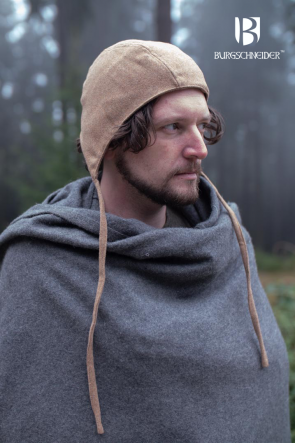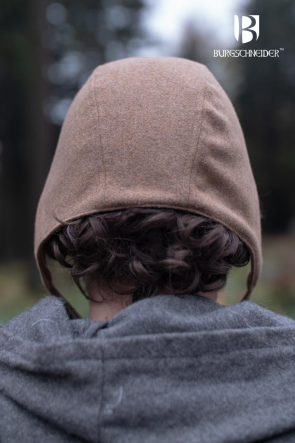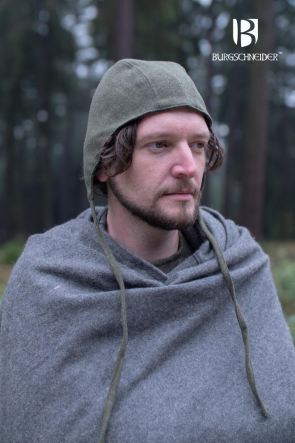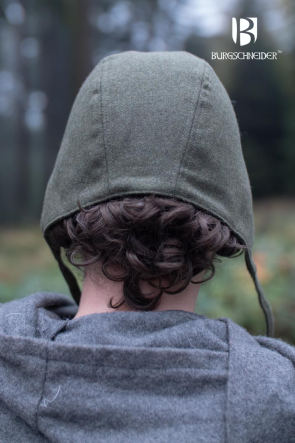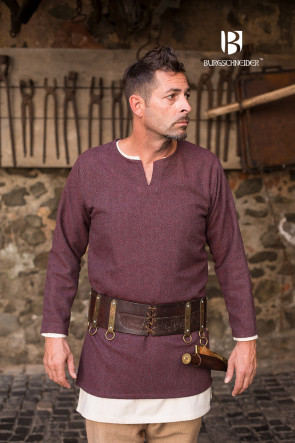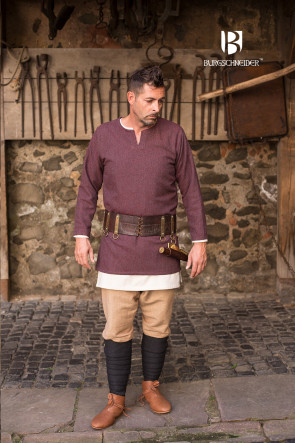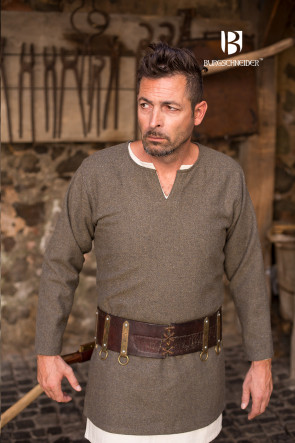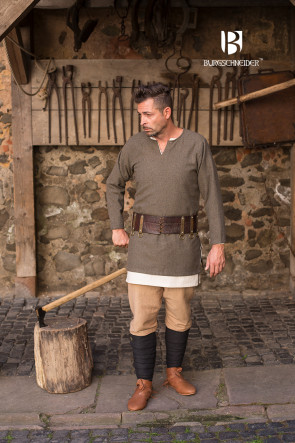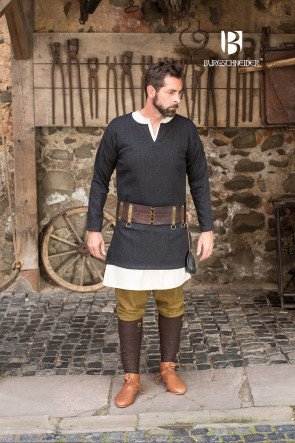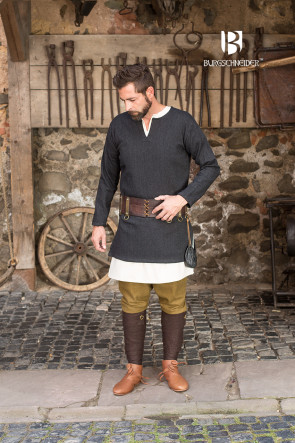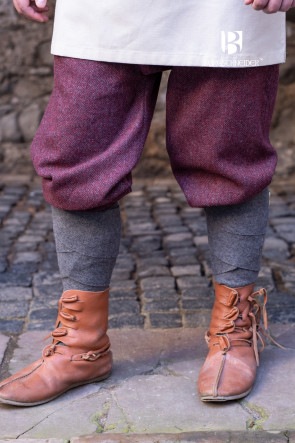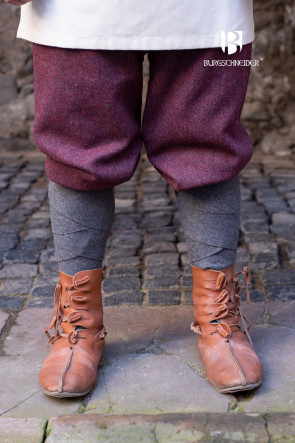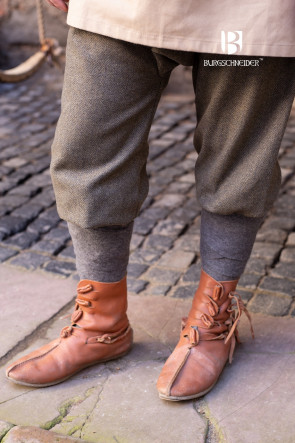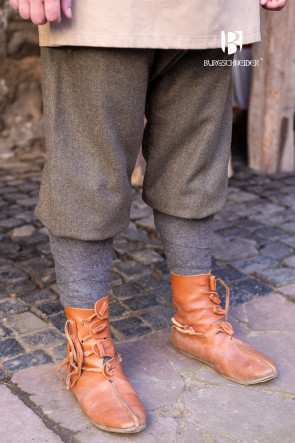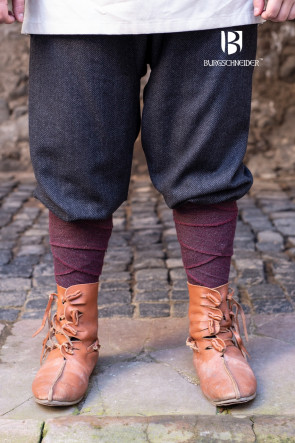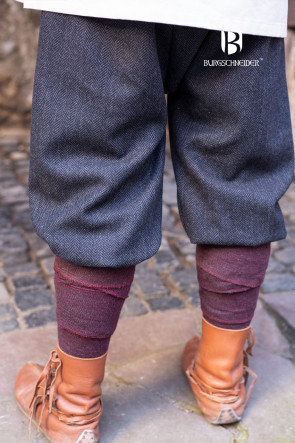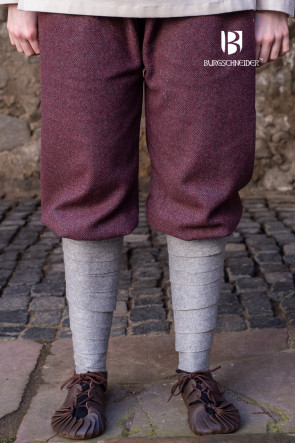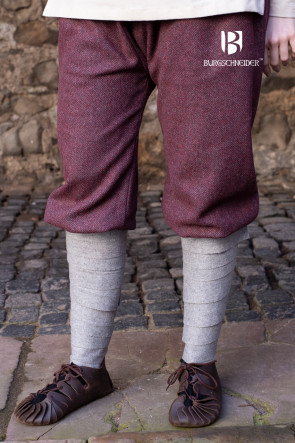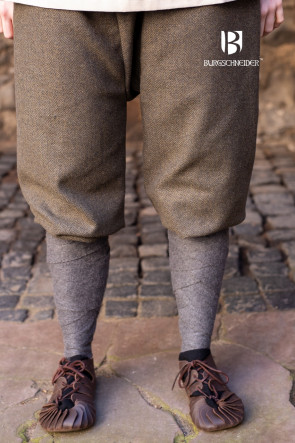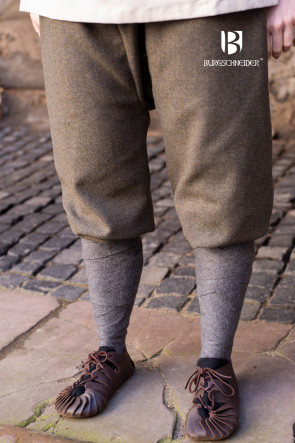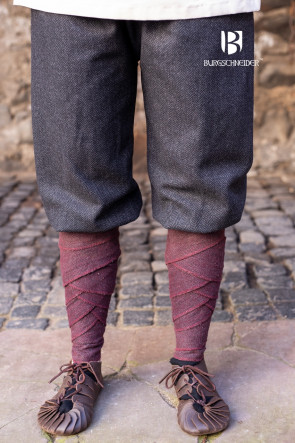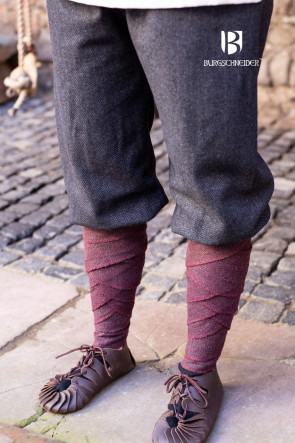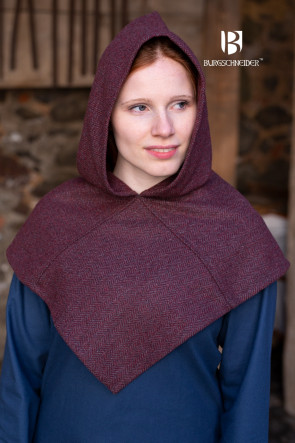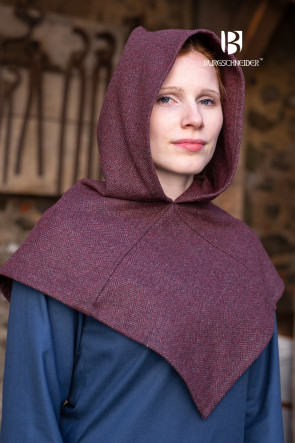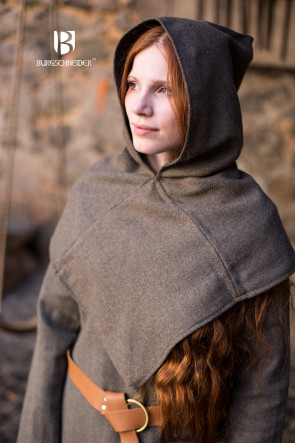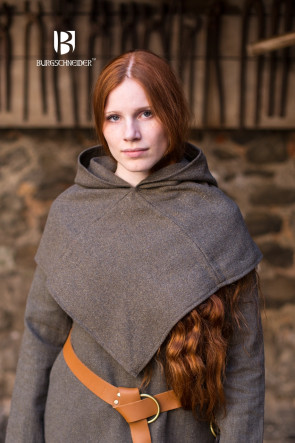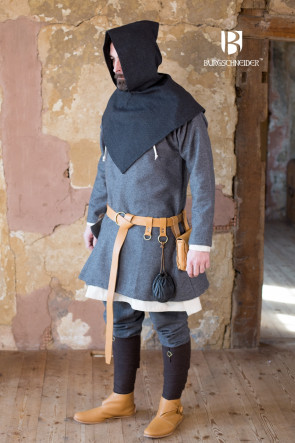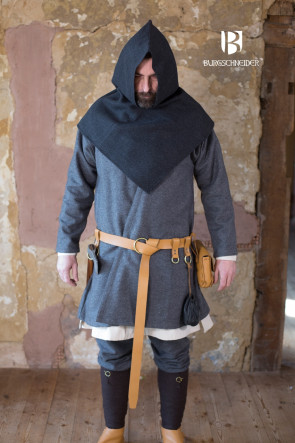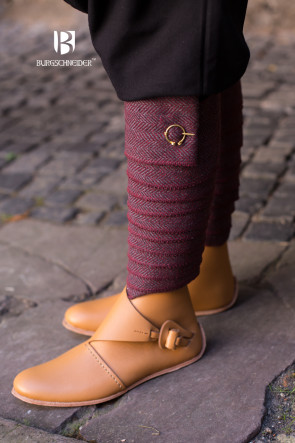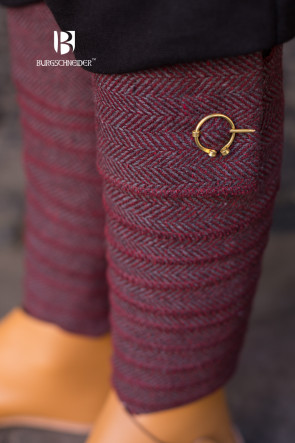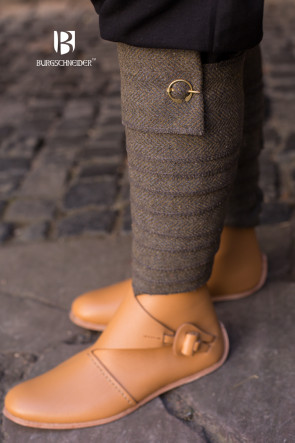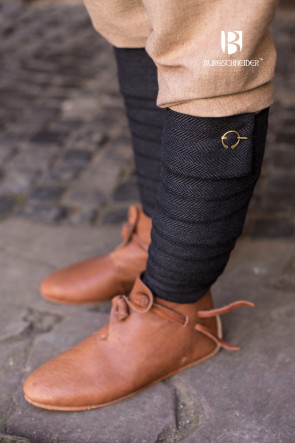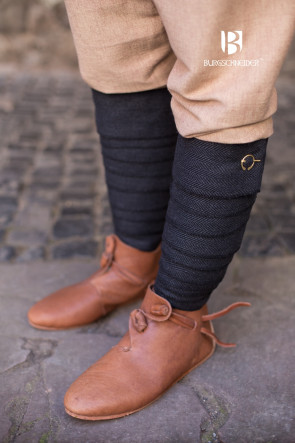Herringbone
What is Wiltshire Herringsbone?
Wiltshire Herringbone is a a woolen fabric in a herringbone weave with a soft feel and an elegant drape, manufactured exclusively for Burgschneider. The iconic herringbone weave is popular in modern portrayals of Vikings and other characters from the European Early Middle Ages. However, the pattern has also been discovered in much older textile findings—even in samples dating back to antiquity.
What characterizes Wiltshire Herringbone?
In winter,
Wiltshire Herringbone’s densely woven fibers allow the wearer to stay warm while simultaneously keeping dampness out, and even in summertime, the wool content provides a pleasant, cooling effect.
The blend of 60% wool, 37% polyester, and 3% nylon combines the advantageous qualities of both natural and artificial fibers: it minimizes the pilling found in pure wool fabrics and reduces their scratchy feeling on the skin, while at the same time ensuring greater resistance to tearing. This way, our Wiltshire Herringbone is ideally suited for sturdy medieval clothing and fantasy costumes.
Historical references to the herringbone weaving pattern
-
25,13 €
-
25,13 €
-
Fischgrättunika Tyr - Bordeaux/Grau
Our Tunic Tyr Herringbone is a real eye-catcher. It is a long-sleeved tunic with a small slit neckline that can be embellished with a brooch, for example. It can be worn alone or with an under tunic. In terms of color our Winingas Asgar as well as our Skjoldehamm Cowl Knud, which are made of the same fabric, match it beautifully.
The tunic as such is a very old garment, which evolved from two cloths worn rectangularly attached to the shoulders by brooches to a sewn together form with sleeves. From lower garment it became upper garment, depending on the time and class. Most often it was worn belted. Tunics can also vary greatly in length. Shorter tunics are more practical for work.
Mehr erfahren69,90 € -
Fischgrättunika Tyr - Oliv/Grau
Our Tunic Tyr Herringbone is a real eye-catcher. It is a long-sleeved tunic with a small slit neckline that can be embellished with a brooch, for example. It can be worn alone or with an under tunic. In terms of color our Winingas Asgar as well as our Skjoldehamm Cowl Knud, which are made of the same fabric, match it beautifully.
The tunic as such is a very old garment, which evolved from two cloths worn rectangularly attached to the shoulders by brooches to a sewn together form with sleeves. From lower garment it became upper garment, depending on the time and class. Most often it was worn belted. Tunics can also vary greatly in length. Shorter tunics are more practical for work.
Mehr erfahren69,90 € -
Fischgrättunika Tyr - Schwarz/Grau
Our Tunic Tyr Herringbone is a real eye-catcher. It is a long-sleeved tunic with a small slit neckline that can be embellished with a brooch, for example. It can be worn alone or with an under tunic. In terms of color our Winingas Asgar as well as our Skjoldehamm Cowl Knud, which are made of the same fabric, match it beautifully.
The tunic as such is a very old garment, which evolved from two cloths worn rectangularly attached to the shoulders by brooches to a sewn together form with sleeves. From lower garment it became upper garment, depending on the time and class. Most often it was worn belted. Tunics can also vary greatly in length. Shorter tunics are more practical for work.
Mehr erfahren69,90 € -
Rushose Ivar Fischgrät - Bordeaux/Grau
- Genre: Historic
- Sizes: S- XXXL
- Product Details:
- Material: Wiltshire Herringbone 60% Wool, 37% Polyester, 3% Nylon
- The colours shown may differ from the actual colours depending on the monitor and resolution of your computer.
Based on the historic Rusvik model, these trousers feature a herringbone weaving pattern, which was particularly popular throughout early medieval Europe. Not only is this design historically accurate, particularly for viking characters, but it gives the fabric a very interesting look that pops. The Rus Pants have short legs and can be accompanied by leg-wrappings, like in the photo.
Mehr erfahren64,90 € -
Rushose Ivar Fischgrät - Oliv/Grau
- Genre: Historic
- Sizes: S- XXXL
- Product Details:
- Material: Wiltshire Herringbone 60% Wool, 37% Polyester, 3% Nylon
- The colours shown may differ from the actual colours depending on the monitor and resolution of your computer.
Based on the historic Rusvik model, these trousers feature a herringbone weaving pattern, which was particularly popular throughout early medieval Europe. Not only is this design historically accurate, particularly for viking characters, but it gives the fabric a very interesting look that pops. The Rus Pants have short legs and can be accompanied by leg-wrappings, like in the photo.
Mehr erfahren64,90 € -
Rushose Ivar Fischgrät - Schwarz/Grau
- Genre: Historic
- Sizes: S- XXXL
- Product Details:
- Material: Wiltshire Herringbone 60% Wool, 37% Polyester, 3% Nylon
- The colours shown may differ from the actual colours depending on the monitor and resolution of your computer.
Based on the historic Rusvik model, these trousers feature a herringbone weaving pattern, which was particularly popular throughout early medieval Europe. Not only is this design historically accurate, particularly for viking characters, but it gives the fabric a very interesting look that pops. The Rus Pants have short legs and can be accompanied by leg-wrappings, like in the photo.
Mehr erfahren64,90 € -
Rushose Tilda Fischgrät - Bordeaux/Grau
- Genre: Historic
- Sizes: S- XXXL
- Product Details:
- Material: Wiltshire Herringbone 60% Wool, 37% Polyester, 3% Nylon
- The colours shown may differ from the actual colours depending on the monitor and resolution of your computer.
Based on the historic Rusvik model, these trousers feature a herringbone weaving pattern, which was particularly popular throughout early medieval Europe. Not only is this design historically accurate, particularly for viking characters, but it gives the fabric a very interesting look that pops. The Rus Pants have short legs and can be accompanied by leg-wrappings, like in the photo.
Mehr erfahren64,90 € -
Rushose Tilda Fischgrät - Oliv/ Grau
- Genre: Historic
- Sizes: S- XXXL
- Product Details:
- Material: Wiltshire Herringbone 60% Wool, 37% Polyester, 3% Nylon
- The colours shown may differ from the actual colours depending on the monitor and resolution of your computer.
Based on the historic Rusvik model, these trousers feature a herringbone weaving pattern, which was particularly popular throughout early medieval Europe. Not only is this design historically accurate, particularly for viking characters, but it gives the fabric a very interesting look that pops. The Rus Pants have short legs and can be accompanied by leg-wrappings, like in the photo.
Mehr erfahren64,90 € -
Rushose Tilda Fischgrät - Schwarz/ Grau
- Genre: Historic
- Sizes: S- XXXL
- Product Details:
- Material: Wiltshire Herringbone 60% Wool, 37% Polyester, 3% Nylon
- The colours shown may differ from the actual colours depending on the monitor and resolution of your computer.
Based on the historic Rusvik model, these trousers feature a herringbone weaving pattern, which was particularly popular throughout early medieval Europe. Not only is this design historically accurate, particularly for viking characters, but it gives the fabric a very interesting look that pops. The Rus Pants have short legs and can be accompanied by leg-wrappings, like in the photo.
Mehr erfahren64,90 € -
Skjoldehamn Gugel Knud Fischgrät - Bordeaux/Grau
The Skjoldehamn Cowl was discovered in a pagan grave from the first half of the 11th century. This is one of the first examples of the headgear "Gugel" itself.
Mehr erfahren
The hood has a basic square shape, characteristically the wide brim ends with a corner on the chest.
The grave find from Skjoldehamn raised many questions since its recovery in 1936 and still occupies today. According to current research, the dating of the pagan grave in the marshland is the first half of the 11th century. The hood of the gugel from Skjoldehamn has a simple square basic shape and a very wide brim which does not fall round but with a corner on the chest. This gugel is also a very early example of the type of headgear that became a ubiquitous garment in Europe during the Middle Ages.
In the course of research, attempts were made to assign the garment to a gender and cultural group. For this purpose, not only the DNA of the buried person was examined more closely but also the additional finds. The enclosed trousers determined the theory of the researchers that the person must have been male. DNA examination in 1999 showed no Y chromosome present in the bones which supported the theory that it had to be a woman instead. However, this methodology is considered outdated.
The question of culture points to Norway. This is assumed by ornamentation and morphological features which suggest that the buried person was a Sami tribal member. Further research is needed, as some key evidence for these hypotheses is still lacking. More modern DNA analysis and research into the history of the fashions of the various Sami groups will shed light on this.34,90 € -
Skjoldehamn Gugel Knud Fischgrät - Oliv/Grau
The Skjoldehamn Cowl was discovered in a pagan grave from the first half of the 11th century. This is one of the first examples of the headgear "Gugel" itself.
Mehr erfahren
The hood has a basic square shape, characteristically the wide brim ends with a corner on the chest.
The grave find from Skjoldehamn raised many questions since its recovery in 1936 and still occupies today. According to current research, the dating of the pagan grave in the marshland is the first half of the 11th century. The hood of the gugel from Skjoldehamn has a simple square basic shape and a very wide brim which does not fall round but with a corner on the chest. This gugel is also a very early example of the type of headgear that became a ubiquitous garment in Europe during the Middle Ages.
In the course of research, attempts were made to assign the garment to a gender and cultural group. For this purpose, not only the DNA of the buried person was examined more closely but also the additional finds. The enclosed trousers determined the theory of the researchers that the person must have been male. DNA examination in 1999 showed no Y chromosome present in the bones which supported the theory that it had to be a woman instead. However, this methodology is considered outdated.
The question of culture points to Norway. This is assumed by ornamentation and morphological features which suggest that the buried person was a Sami tribal member. Further research is needed, as some key evidence for these hypotheses is still lacking. More modern DNA analysis and research into the history of the fashions of the various Sami groups will shed light on this.34,90 € -
Skjoldehamn Gugel Knud Fischgrät - Schwarz/Grau
The Skjoldehamn Cowl was discovered in a pagan grave from the first half of the 11th century. This is one of the first examples of the headgear "Gugel" itself.
Mehr erfahren
The hood has a basic square shape, characteristically the wide brim ends with a corner on the chest.
The grave find from Skjoldehamn raised many questions since its recovery in 1936 and still occupies today. According to current research, the dating of the pagan grave in the marshland is the first half of the 11th century. The hood of the gugel from Skjoldehamn has a simple square basic shape and a very wide brim which does not fall round but with a corner on the chest. This gugel is also a very early example of the type of headgear that became a ubiquitous garment in Europe during the Middle Ages.
In the course of research, attempts were made to assign the garment to a gender and cultural group. For this purpose, not only the DNA of the buried person was examined more closely but also the additional finds. The enclosed trousers determined the theory of the researchers that the person must have been male. DNA examination in 1999 showed no Y chromosome present in the bones which supported the theory that it had to be a woman instead. However, this methodology is considered outdated.
The question of culture points to Norway. This is assumed by ornamentation and morphological features which suggest that the buried person was a Sami tribal member. Further research is needed, as some key evidence for these hypotheses is still lacking. More modern DNA analysis and research into the history of the fashions of the various Sami groups will shed light on this.34,90 € -
29,90 €
-
29,90 €
-
29,90 €








